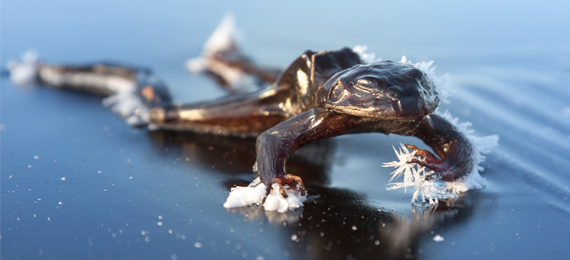
Mother nature is hard to explain, so are her creations. There are many fascinating creatures in the world, and they do various activities for their survival. As the phrase says, “Survival of the fittest” many animals try to adapt to the environment for their survival. But have you ever wondered how animals adapt and survive in freezing temperatures? Here we’ve clubbed the animals that freeze and come back to life.
1.Painted Turtle Hatchling
Hatchlings of the painted turtle have the tendency to adopt harsh winters. They can even survive the ice formation within their tissues. Painted turtle hatchlings can be found in freshwater habitats in Canada and the United States. Adult painted turtles can survive in 37 degrees Fahrenheit water without food and oxygen for up to 100 days. These conditions would kill humans and animals in just three or four minutes. A reduced metabolic rate is a key secret to their survival.
2.Tardigrade
Tardigrades are small aquatic creatures often called water bears or moss piglets. Tardigrade can persist in extremely cold temperatures by deactivating its metabolism. They kill most other forms of life by transforming into a dehydrated ball known as tun or cryptobiosis. Researchers say tardigrades can withstand minus 200 degrees Celcius and also hotter than 300 degrees celsius.
What Creature Survived Being Frozen for 30 Years?
- A. Tardigrade
- B. Clown Fish
- C. Squid
- D. None of the Above
3.Wood frog
Wood frogs are one of the forest-dwelling frogs that freezes and comes back to life.
They are found primarily throughout the forests of Alaska and the Northeast. Wood frogs eat a variety of small forest floor invertebrates. They are popularly known for their cold tolerance because they can freeze their body up to 70%, including the brain and eye lens. Wood frogs survive till their heart and muscles completely stop. Urea is accumulated in tissues in preparation for overwintering, and liver glycogen is converted into glucose in large quantities during winter. Both urea and glucose act as cryoprotectants to limit ice formation and reduce the osmotic shrinkage of cells. During spring, their hard body gets back to normal.
4.Alligator
Alligators are cold-blooded, and they don’t generate their own body heat. So they go into a state of hibernation. Alligators lower the heat and metabolism by a process known as brumation. They also use a simple and intelligent trick to escape the cold temperature. The trick is nothing but sticking their snouts out above ice. They maintain breathing movement with their nose until the temperature warms up.
5.Darkling beetle
Darkling beetles belong to the family Tenebrionidae. Around 15,000 species of this family are found in temperate and tropical regions. They survive cold temperatures by protecting watery cells from freezing. Darkling beetles produce a sugar-based antifreeze called xylomannan, which stops ice formation in the cells of beetles.